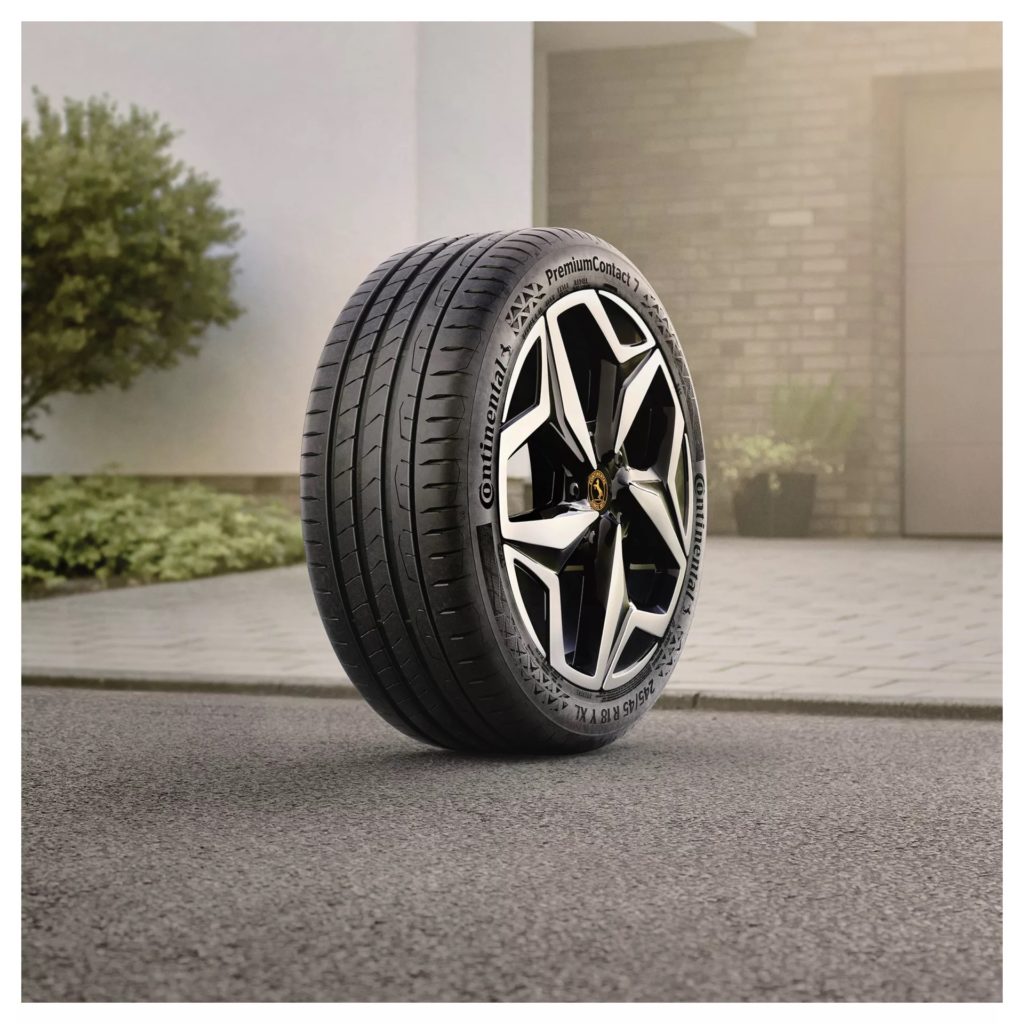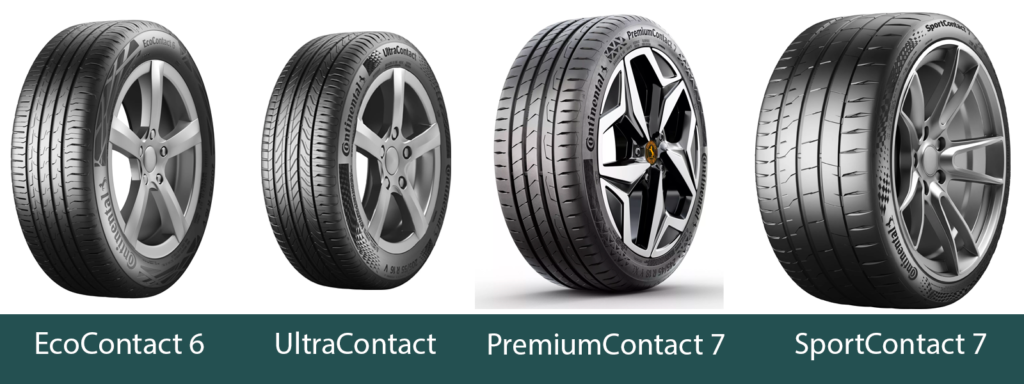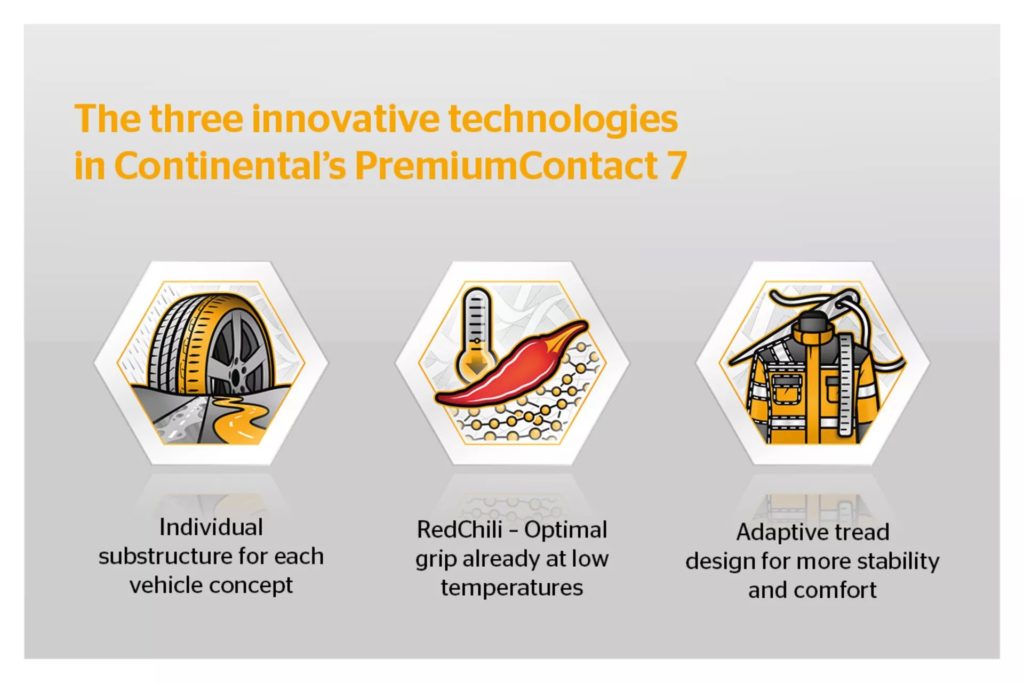Today, as part of our regular series, we take a look at another new addition to the summer tyre market, the long-awaited successor to Continental’s PremiumContact range, now in its seventh version.
☰
A little history …
The lifecycle of the previous sixth version was quite long – it was launched in 2016 and was thus on the market for a long 6 years. Even so, after all these years, it has managed to pick up successes in current tests – for example, 2nd place in the ADAC test for 2023. By the way, it has an impressive 36 tests in total, according to our system. The tyre was praised for most of its features, with low aquaplaning margins and delayed steering response being frequently cited minor shortcomings.
The new PremiumContact 7 addresses these very shortcomings, and while aquaplaning is still one of the tire’s weaker points, it’s only a minor flaw. But where the novelty has worked the hardest is in the aforementioned delayed steering response, or rather the sportiness of the tyre itself. The sixth generation could be deservedly blamed for this, despite the PremiumContact range being listed in the Touring class, not UHP (and Continental doesn’t currently offer any UHP tyres). The PremiumContact 7, however, can no longer be faulted in any way. It offers a surprisingly sporty ride for its class, partially competing with the SportContact range.

A new summer tread with sporty, dynamic handling characteristics, precise steering, good performance and economy.
– Autobild 2023, 225/45 R18
PremiumContact in the Continental model range
But let’s take a look at where the PremiumContact fits into the Continental model range. The German manufacturer currently offers the following main summer tyre models for passenger cars: the EcoContact 6, UltraContact, PremiumContact 7 and SportContact 7. While the EcoContact and UltraContact are mainly focused on mileage and fuel economy and offer mainly safe driving characteristics for less powerful cars (although the UltraContact is also aimed at more powerful cars and is offered in versions up to 300km/h), the PremiumContact 7 already offers a greater focus on driving enjoyment. But for downright sporty performance over longer periods of time, there’s the SportContact 7, which is the ideal compromise between sharp driving and everyday usability.

Technology used
But of course the PremiumContact range shouldn’t just be about sporty driving – and it isn’t. In particular, its strengths lie in its ideal mix of driveability, efficiency and comfort. This adaptability is mainly due to the innovative RedChili compound, which optimises performance over a wide temperature range. This ensures high grip even at low temperatures without a warm-up phase, which is advantageous in the transitional spring and autumn months, reducing the frequency of tyre changes and the associated costs. In addition, the tyre’s adaptive tread design provides greater stability and ride comfort on wet and dry roads, reducing driver fatigue and improving the overall driving experience. In addition, the tyre offers higher mileage performance, which has been tested over a total of 150,000 kilometres of driving tests and optimised, resulting in a ten per cent increase in mileage compared to its predecessor, the PC6.

PremiumContact 7 in tyre tests
But let’s take a look at the test results – we have 3 so far. The “worst” ranking for the new tyre was in the Autobild test in the 225/45 R17 size, where it came third, beaten by the Goodyear Eagle F1 Asymmetric 6 (★93) and Michelin Pilot Sport 5 (★96). While the PC7 was easily able to keep up with them in the wet and at least match the Michelin in the dry (the Goodyear edged them both out thanks to its excellent dry handling, braking distance and comfort), the final third place was sealed by the economy part of the test, which is 1/3 of the final rating. There, Autobild gives a staggering 60% of the overall mark to mileage and another 20% to the price/performance ratio, which is directly tied to mileage. And that’s where the projected mileage of the PremiumContact 7, which Autobild says is 51,600 km, falls short of the 55,600 km of the Michelin and the impressive 63,200 km of the Goodyear, which is also the cheapest of the three tyres. Even so, these are the three tyres with the highest mileage in the test; by comparison, the next newcomer, the Bridgestone Turanza 6 (★77), has a mileage of just over 40,000 km.
| Ranking | Organization | Rating | Dimension | Year |
|---|---|---|---|---|
| 5 | Vibilagare | Good | 235/55 R19 | 2025 |
| 1 | TYRE REVIEWS | Test winner | 225/50 R17 | 2025 |
| 2 | Autozeitung | Highly recommended | 225/45 R18 | 2025 |
| 2 | Aftonbladet | Outstanding | 225/45 R17 | 2025 |
| 8 | Autobild | 225/40 R18 | 2025 | |
| 4 | Autobild | Exemplary | 225/40 R18 | 2025 |
| 2 | Autobild | Exemplary | 215/55 R18 | 2025 |
| 1 | Automotorsport | Test winner | 235/55 R18 | 2024 |
| 2 | Autobild | Exemplary | 225/55 R17 | 2024 |
| 1 | Autozeitung | Test winner | 225/45 R17 | 2024 |
| 1 | ACE | Highly recommended | 225/45 R17 | 2024 |
| 1 | Vibilagare | 215/55 R17 | 2024 | |
| 1 | ADAC | Good | 215/55 R17 | 2024 |
| 1 | Sportauto | Test winner | 215/40 R18 | 2024 |
| 2 | Autobild | Exemplary | 205/55 R16 | 2024 |
| 1 | Autobild | 205/55 R16 | 2024 | |
| 5 | Autobild | 225/45 R18 | 2023 | |
| 3 | Autobild | Outstanding | 225/45 R18 | 2023 |
| 2 | ACE | Highly recommended | 225/45 R18 | 2023 |
| 1 | Tyre Reviews | Test winner | 225/40 R18 | 2023 |
| 1 | Tyre Reviews | Test winner | 205/55 R16 | 2023 |
| 1 | Autoklub ČR | 205/55 R16 | 2023 |
The next test was by TyreReviews.com, this time in the very popular smaller 205/55 R16 size. There, the PremiumContact 7 won, however, precisely because of the smaller size it didn’t have a newcomer alongside it this time from the competition, which took the win in the Autobild test. Goodyear offers the EfficientGrip Performance and Michelin the Primacy 4+ in this size, both aimed at operating economy rather than sporty handling. But Continental’s strategy of offering one tread pattern for a wide range of car categories is paying off. It’s available in a range of sizes from R16 to R21.
Evaluation and competition
We’re still waiting for more tests, but from the available tests we can see who the tyre is suitable for – it’s the ideal mix of handling, sportiness, mileage and comfort. If you prefer more frequent sporty driving, perhaps the new SportContact 7 is also a better model for you, but again, for a UUHP tyre, they focus quite a lot on comfort, so they’re not as different to the PremiumContact 7 as the class categorisation might suggest.
It also depends on the size you choose the tyre in – while it will definitely be one of the sportier tyres among the R16s, it’s more of a comfort tyre in the R19s. Its main competitors include the aforementioned Michelin Pilot Sport 5 and Goodyear Eagle F1 Asymmetric 6, but also the Bridgestone Potenza Sport (★87) or Turanza 6 from the same manufacturer.